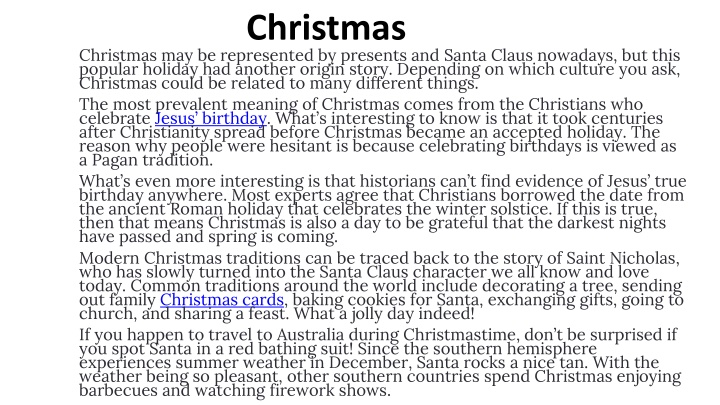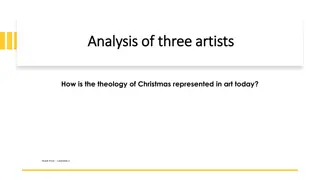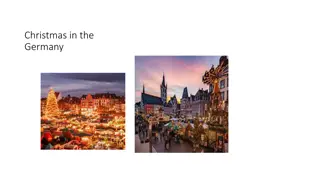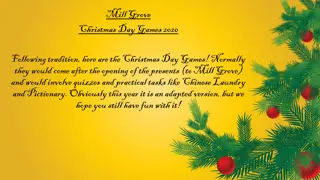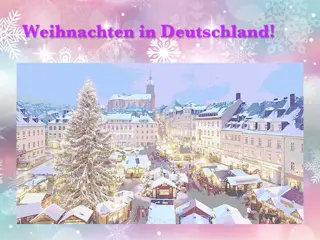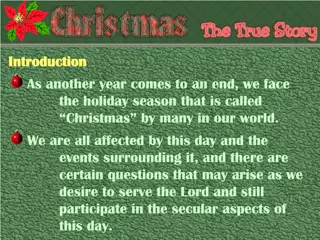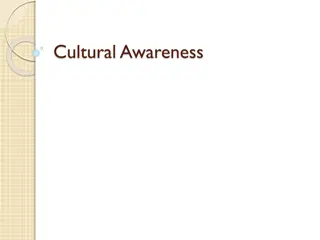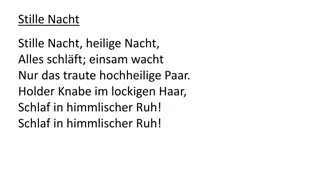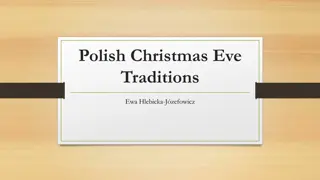Unveiling the Origins of Christmas: A Cultural Exploration
The diverse origins of Christmas beyond the modern representations of presents and Santa Claus. Various cultures offer unique perspectives on the holiday's significance, revealing a rich tapestry of traditions and stories. Discover the historical roots that have shaped the celebration we know today."
Download Presentation

Please find below an Image/Link to download the presentation.
The content on the website is provided AS IS for your information and personal use only. It may not be sold, licensed, or shared on other websites without obtaining consent from the author.If you encounter any issues during the download, it is possible that the publisher has removed the file from their server.
You are allowed to download the files provided on this website for personal or commercial use, subject to the condition that they are used lawfully. All files are the property of their respective owners.
The content on the website is provided AS IS for your information and personal use only. It may not be sold, licensed, or shared on other websites without obtaining consent from the author.
E N D
Presentation Transcript
Christmas Christmas may be represented by presents and Santa Claus nowadays, but this popular holiday had another origin story. Depending on which culture you ask, Christmas could be related to many different things. The most prevalent meaning of Christmas comes from the Christians who celebrate Jesus birthday. What s interesting to know is that it took centuries after Christianity spread before Christmas became an accepted holiday. The reason why people were hesitant is because celebrating birthdays is viewed as a Pagan tradition. What s even more interesting is that historians can t find evidence of Jesus true birthday anywhere. Most experts agree that Christians borrowed the date from the ancient Roman holiday that celebrates the winter solstice. If this is true, then that means Christmas is also a day to be grateful that the darkest nights have passed and spring is coming. Modern Christmas traditions can be traced back to the story of Saint Nicholas, who has slowly turned into the Santa Claus character we all know and love today. Common traditions around the world include decorating a tree, sending out family Christmas cards, baking cookies for Santa, exchanging gifts, going to church, and sharing a feast. What a jolly day indeed! If you happen to travel to Australia during Christmastime, don t be surprised if you spot Santa in a red bathing suit! Since the southern hemisphere experiences summer weather in December, Santa rocks a nice tan. With the weather being so pleasant, other southern countries spend Christmas enjoying barbecues and watching firework shows.
Sports day Japan Also known as Health and Sports Day, or Taiiku no Hi if you re in Japan, this Japanese national holiday commemorates the opening of the 1964 Olympics held in Japan. Held annually on the 2nd Monday of October, it aims to promote an active and healthy lifestyle. Celebrated throughout Japan, many towns, schools and businesses hold their own events to celebrate the day in which traditional sports day races and games are played. Alongside this, O-tama korogashi is traditionally played, O-tama korogashi is a relay race in which team members take turns to roll a ball as big as a person down a field, around cones and back up to the next pair for them to do the race. This is one of many national holidays held in Japan as they have 16 throughout the year!
Groundhog day America and Canada Celebrated on February 2nd, this tradition is celebrated over parts of both America and Canada, however the official groundhog, Punxsutawney Phil, lives at Gobbler s Knob near Punxsutawney, Pennsylvania. Deriving from the Pennsylvania Dutch superstition, it s said that on the day, the groundhog emerging from its burrow sees its shadow due to clear weather, it will retreat to its den and winter will persist for six more weeks; if it does not see its shadow because of cloudiness, spring will arrive early. Despite it being a popular tradition, studies have shown there s no official correlation between a groundhog seeing it s shadow and the arrival of spring. Despite there being no correlation, it s still a popular tradition with the home of Punxsutawney Phil having attracted thousands of visitors over the years.
Hangul Proclamation Day, South Korea/Chos n g l Day, North Korea Known as Hangeul Proclamation day and celebrated on 9th October in South Korea as a public holiday and known as Chos n g l Day and celebrated on 15th January in North Korea, this celebration of the Korean Alphabet is important to Korea and Korean culture. Whilst the origins of many alphabets across the world are largely unknown and derive from pictures and symbols, Korea s alphabet was intentionally created. Prior to Hangul s creation, Korean s were using Chinese characters to write, these were very different from the Korean language which made it it made it incredibly hard for Korean s to become literate. Korea s king at the time, King Sejong, ordered the creation of the Korean alphabet in 1443, by 1444 it had been created and has been used ever since!
La tomatina day Buol, Spain Attracting thousands of people every year, La Tomatina is a festival held in Bu ol, Spain. This festival isn t one you ll be wanting to wear your best outfits to however as it s essentially a food fight in which around 150,000 overripe tomatoes are thrown. The start of the festival is marked by water cannons being fired and then the chaos begins. Whilst maybe not one for the feint of heart, there s safety rules in place such as the rule that the tomatoes must be squished before they can be thrown and participants aren t allowed to take any additional items in such as bottles or hard objects. As soon as the 2nd water cannons are fired, an hour after the first, the fight must come to an end. Fire trucks are then deployed to clean the streets with water from a Roman aqueduct. Participants often flock to the nearby Bu ol river to clean themselves.
Bermuda day Bermuda Bermuda day is held on the final Friday in May, and as it s name would Suggest, Bermuda day is a public holiday in Bermuda. Held to celebrate the Island s heritage as well as to signify the beginning of summer, celebrations such as parades are held in the streets of Bermuda day to commemorate the event. From Bermuda day onwards, it s considered warm enough to swim in the sea and Bermuda shorts can be worn in the office following Bermuda day.
Up Helly Aa Shetland Islands Up Helly Aa is a celebration held to mark the end of the Yule season. With various communities within the Shetland islands having different celebrations, the annual festival held in Lerwick is known as Sheltand s biggest festival. Dating back to 1881 and lasting one day (and the following night), the festival is a celebration of the Island s history and a demonstration of Islander s skills. Various events take place throughout the day including a marches and visits and up to 1,000 participants or guizers as they re known parading the streets in the evening. Guizers celebrate their Norse heritage in the event by dressing up in traditional viking attire.
Mountain Day Japan The newest of Japan s 16 national holidays, legislation states that Mountain Day is intended is to provide opportunities to get familiar with mountains and appreciate blessings from mountains . Known as Yama no hi in Japan and having only been an official public holiday since 2016, Mountain day doesn t have any traditional celebrations associated with it just yet. This doesn t mean that it cannot be celebrated though, around 70% of Japan s landmass is mountainous therefore activities such as hiking and skiing are popular in Japan and some choose to celebrate by doing one of these activities.
May Day United Kingdom May Day is a bank holiday in the United Kingdom, traditionally held on the 1st May but now held on the first Monday in May. Dating back to ancient times, Romans would celebrate the festival of Flora, Goddess of flowers and spring and in Britain, and Celtic people would celebrate the festival of Beltane to mark the half way point between spring and summer. Whilst many Brits no longer celebrate the bank holiday the way it s traditionally been celebrated, there s still a number of traditional such dancing around the maypole and Morris Dancing which have lived on to the 21st Century.
Oktoberfest in Munich Germany s most iconic Volkfest, Oktoberfest attracts millions of people to the city to enjoy Bavarian beer and food, live bands, and parades. This 3-week-long festivity kicks off with a vibrant parade of carriages, floats, and people in traditional costumes, before congregating at the Theresienwiese fairground. You can find hundreds of large tents with gallons of beers provided by renowned Munich breweries, with traditional Bavarian music blaring out of massive speakers throughout the day. Fairground rides such as Ferris wheels, miniature trains, and merry-go- rounds offer hours of fun for visitors too young to drink.
